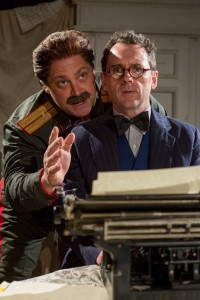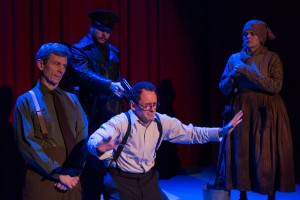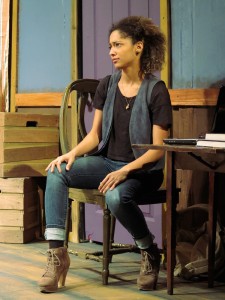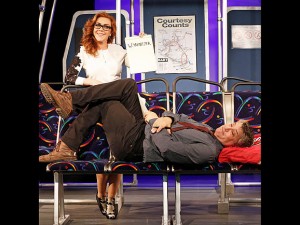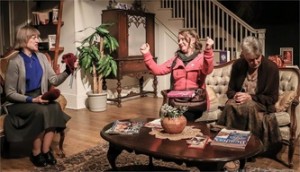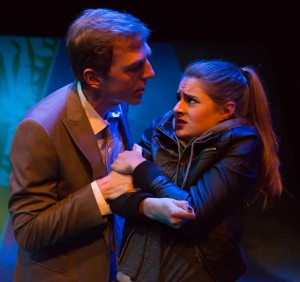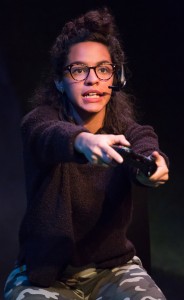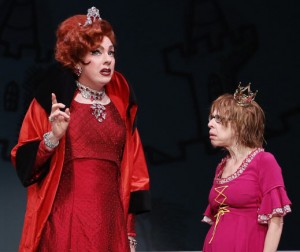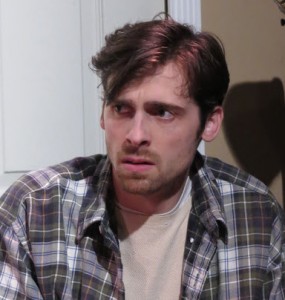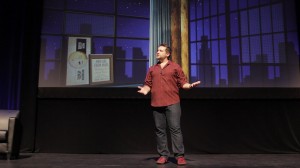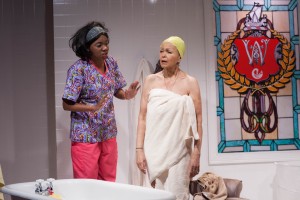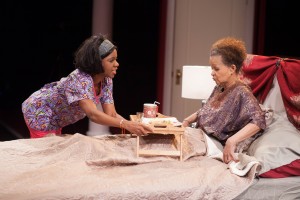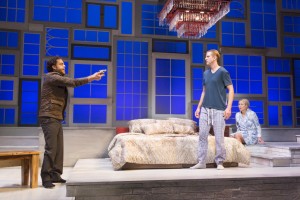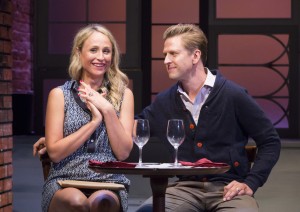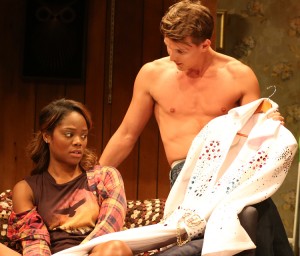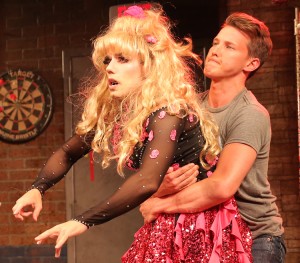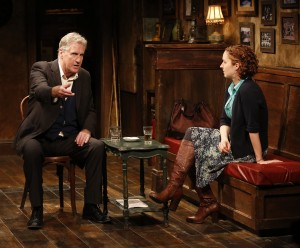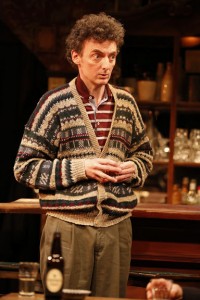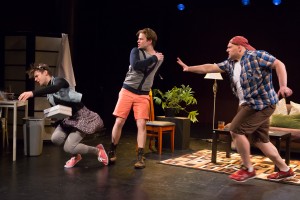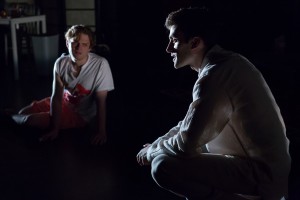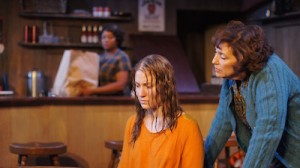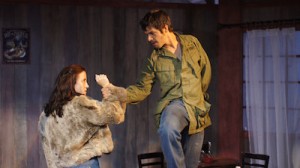The aptly named Commedia dell’Artichoke doesn’t veer far from its roots—commedia dell’arte, the knockabout comedy style of Renaissance Italy. Carlo Goldoni’s The Servant of Two Mastersis a prime example, and although it is occasionally seen on stage nowadays, it was adapted exuberantly into the Broadway hit One Man, Two Guvnors with James Corden, who won a Tony Award for his slapstick performance.
Untold Kremlin Brotherhood
Have you ever had dreamed of meeting a person of great importance? Did your dream become a reality? Perhaps that person changed your life. That is exactly what happens to acclaimed Russian playwright Mikhail Bulgakov in John Hodge’s Collaborators. Bulgakov’s dreams, well in his case, nightmares come true in this black comedy set in 1938 in Moscow, Russia. We enter into the world of Bulgakov. It is rumored that Joseph Stalin went to see Bulgakov's play, The White Guard, 15 times (In actual history, it was the play The Day of the Turbins based on the novel The White Guard, and it is said that Stalin saw it over 30 times). Although the run of his current play, The Life of Monsieur de Molière, is successful, Bulgakov is living in dire straits. He lives in a shared apartment provided by the housing committee with his wife Yelena. There is no heat, nor water, scarcely any food to be found, and his body is plagued with disease.
To top it all, Bulgakov is confronted by the NKVD (secret Soviet military police). They tell Bulgakov that he is to write a play about Stalin to be performed at his 60th birthday celebration. When he says "no," they tell him that The Life of Monsieur de Molière will be shut down. He will write the show about Stalin or parish in “the rooms." Reluctant and fearful Bulgakov sits in front of his typewriter desperate for the words to start flowing. A mysterious voice on the phone tells Bulgakov that he can help him. Bulgakov then enters the tunnels under Moscow to meet this mystery person in a secret room under the Kremlin. Who does this haunting voice belong to? It turns out to be Joseph Stalin himself. The men become frenemies and the rest of the play focuses on the wildly twisted relationship between Bulgakov and Stalin.
John Hodge’s play is a witty seriocomic political satire that tickles your funny bone and sends shivers down your spine at the same time. His comedy is the type to slap you in the face and leave a sting. He takes truthful facts and spins them into lines that will have you laughing in 10 seconds flat. For example, the way the character of the first doctor acknowledges knowing Bulgakov with the line “smack head doc turned smut-scribe” is brilliant.
The Grand Hall at St. Mary’s Church, a prewar industry-style brick laid basement in New York City, is the perfect setting for this show. It defiantly enhances the environment of the play, in tandem with a first-rate design team including the set, costumes, lighting and sound. Rebecca Grazi (scenic designer) has created a separate two-stage design that shows the apartment of Bulgakov on one side and what represents parts of Russia on the other side. The center piece of her design is a cupboard even Mother Hubbard would be intrigued by. Her use of color demonstrates the differences between poverty and power. Light dull white, beige and brown hues for Bulgakov’s apartment set in contrast to a striking blood red set of curtains and painted pipes to represent Russia and the Soviet Union. The design may have been more functional in a raised or raked setting. The site lines from the left side of the audience were severely obscured during the scenes that took place in front of the red curtains.
Peter Dobbins' direction is meaningful and done with purpose. Each character is perfectly cast. Robin Haynes does an exceptional job in his portrayal of Vladimir, the power hungry NKVD policeman with self-confidence issues and a desire to rise above his station in life. Haynes’ snarky tone and mocking air is fantastic. Erin Bernard does a lovely job in her role of Yelena as well. She is truly believable as the loving, concerned wife of Bulgakov.
However, this production will be best remembered for its strong casting of the collaborators. Brian J. Carter as the harassed, anxiety-ridden, sickly Bulgakov and Ross DeGraw as a Stalin who delights in playing cat-and-mouse games. Carter’s physical embodiment of Bulgakov is spot on; he is so detailed in the physical that his jaw even trembles when he finds himself trapped by his tormentor’s devious wiles. Ross Degraw is even more impressive in his role as Stalin. He is pleasant and jovial; a man who seems honest and open about his life, seen in his line, “The man who is trapped but his soul is free.” There are even moments of unctuous flattery and warmth from this characterization of Stalin. That is until his eyes suddenly grow black and you see the cold calculating monster that lurks beneath the façade.
If you're a fan of political satire, you will defiantly love this show. Although, if you have very little interest in politics and can’t remember what you learned about Stalin in your 8th grade history books, a recommended brief brush up on the actual history of Stalin’s reign and the life of Bulgakov is advised before coming to this show. You will for sure have a better understanding of who these characters are and why this show is so hilarious.
The Storm Theatre Company’s presentation of Collaborators runs through Feb. 13 at Grand Hall in St. Mary's Church (440 Grand St. between Pitt and Clinton Sts.). Evening performances are Thursday-Saturday at 7:30 p.m. with Saturday matinees at 2 p.m. Tickets are $25 and can be purchased by calling 212-868-4444 or visiting SmartTix.com.
Dilapidated Dreams
What happens when an aging softcore porn director returns to his family home in Levittown, L.I., to sort through the remnants of his childhood while harboring hopes of repairing broken family ties? Allen Wilder 2.0, currently running at Theater for the New City, urgently wants to come to terms with what it means to age while living a life, less than exemplary, full of unfulfilled dreams.
The fast-paced dialogue is handled aptly by three, age-appropriate actors: Joe Casey (Michael Sullivan), Steph van Vlack (Donna Mullins) and Becca Fox (Kayla). A special nod to van Vlack and Casey who, while probably afraid to show it, did very well baring more than their artistic souls.
There is the age-old argument in theater—should the playwright also be the director? Often, having the writer and the director be one in the same provides no distance from the work that is afforded a different director. While the overall direction of Allen Wilder 2.0 by Matt Morillo is exceptional, the challenge is in his script, which brings little that is new to the conversation of self-worth, family dynamics, aging, abandonment, parental divorce, sex, fear of intimacy, and the longing for approval.
The actors, however, bring life to what they were given. Casey embraced the ‘40-something animated male from Los Angeles with charm and certitude. His voice is clear and full of expression and was often burdened with the running gag, “It’s soft core!” when others referred to his directorial work in porn, attempting to somehow make it palpable. Casey’s personal challenge is evidenced with his thigh slaps as the end to arm or shoulder gestures. At second glance, his nude scene is apropos to the events and is played off well with the use of a plastic fireman’s helmet.
Michael’s love interest, albeit for one night, is his former babysitter, Donna, who has 10 years and two children on him. As Donna, van Vlack embodied all the fear of a middle-aged, small-town woman “challenged by gravity.” The character may have been full of fear, however, van Vlack embraced her curvaceous body when Michael was finally able to dispense with her dress. The "come here, go away" choreography between Donna and Michael wore a little thin after time, and the script didn’t provide much room for her character to grow; it left the audience wanting more.
Kayla, Michael’s niece, is argumentatively played by Becca Fox, who is fresh and crisp, with a confident edge to her voice. Kayla’s disdain for her uncle is exacerbated when she inadvertently walks in on the remnants of Michael and Donna’s tryst. Michael fumbled through his attempt to reconcile with her until she revealed that she read his journal that brought to light her grandfather’s overt racism. Given Kayla’s father is black, her mother’s attempt to honor the memory of the man, creates a wedge between Kayla and her mother that appears insurmountable.
The audience arrives to a blaring and lively '80s rock soundtrack. Once the play commenced, the dialogue is fast-paced with a few contemporary references and some humor woven into the script. When offered to drink from a bottle of 25 year-old whiskey, Donna asked, “No glasses, are we animals?” to which Michael slyly replied, “We’ll see.” Unfortunately, the overall script never appeared to find its footing or depth.
Designed by Mark Marcante, the set is the abandoned family home in Levittown. There are a few subtle references to the famous mid-century track homes; a piece of abstract art and two Arthur Umanoff-style wood slat swivel counter stools. Packing boxes are stacked in the corner for Michael to go through the things he left behind, and there is an oddly placed desk, devoid of a lamp or phone, off to the side near the backdoor. The house felt more like an abandoned farmhouse rather than a residual to the testament of the “American dream” for a middle-class family.
The unfortunate thing about the lighting, designed by Amith Chandrashaker, is that no reference is made to night or day; the lights are on. After returning from a night of drinking, Michael and Donna burst on scene, well into the evening, with the porch light lit, while Kayla finds them asleep in the morning all to the same lighting in the second scene. The play takes place over a 12-hour period leaving the imagination to conjure evening, morning and mid-day lighting.
The credit for an enjoyable evening goes to the actors and their willingness to step outside themselves, embodying the characters on the printed page of Allen Wilder 2.0. The kindness portrayed by Michael’s character near the end of the play may not have much lead-in, but offers a glimpse into the generosity of human spirit with the ability to start anew merely by saying so.
Allen Wilder 2.0 runs until Jan. 31 at Theater for the New City (155 First Ave. at East 10th St.). Performances are Thursday-Saturday at 8 p.m. and Sunday at 3 p.m. Tickets are $18 and can be purchased by calling SmartTix at 212-868-4444 or visiting www.smarttix.com. For more information, visit http://www.theaterforthenewcity.net/allenwilder2.html.
An Unlikely Rom-Com Commute
Who says you can’t find love on a train? Trains are very romantic. Anything can happen on a train. And it does to the two star-crossed maybe/maybe-not lovers in Jerry Mayer’s new comedy, 2 Across at St. Luke's Theatre. Evelyn Rudie (Eloise, among many others), directs a cast that stars award-winning performers, Andrea McArdle and Kip Gilman. Streamlined direction and crisp performances keep this tête-a-tête comedy rolling down the tracks on an early morning commute for an entertaining look at love and the lonely.
Two commuters on a San Francisco BART train meet and duke it out over The New York Times crossword puzzle. And the battle of the sexes is on. Janet, played by Andrea McArdle (polished actress of Annie fame), is a psychiatrist who has just said goodbye to her son who joined the Marines against her wishes. Josh, played by actor extraordinaire Kip Gilman, is an out-of-work advertising man. She is a control freak; he is a freewheeler. They clash.You can always tell a person by the way they do a crossword. And they learn much about each other and themselves as they roll down the tracks competing with their puzzles. Josh inadvertently helps her with her son and she helps him regain his confidence to find a job. As they build up and let down their barriers of emotional baggage, we can relate to the inner yearnings of these two lonely people. After “Granite” Janet’s strategy of helping Josh finish the crossword and tearing down her defenses, they find they are just two vulnerable people with the thought of the romantic possibilities.
Full of quick banter reminiscent of the great classic sitcoms such as "Mash" from which Mayer is renowned, 2 Across is stylish and witty. Gilman is a mix of Al Pacino and Alan Alda; a bit quirky, yet macho, and very charming. Used to enticing women with his wits, Josh is surprised to learn that he has a certain physical appeal as well. McArdle is gorgeous as a neurotic Mary Tyler Moore type. The perfect romantic touch is when Josh recites classic love poems to woo her. All it takes to let her defenses down is poetry, a sandwich and a couple of mini bottles. This is true of any woman, right? Josh finally lowers her stoic resistance and by the time it is their stop, she has conceded she will meet him… or not.
Rudie’s lively direction kept the candid dialogue going. The train setting, designed by Scott Heineman, was so detailed; the intercom voice, the sounds and seats were all so specific. But when the actors stood up, there was no acknowledgement of a moving train. They could have made subtle moves to indicate the jumps and jolts of the train to create the feeling that they were in fact travelling. As nimble as these performers were, there could have been choreographed in-sync movements once or twice that would have really enhanced the overall effect. This is only a minor detail in an otherwise seamless performance by an ensemble of consummate professionals.
At curtain call, they sang a lovely duet that was probably the best part of the show. The play definitely lends itself to music. It would have enhanced the evening to hear more of McArdle’s exquisite singing. She is absolutely gorgeous, but the writing somewhat stifled her, often giving Gilman the wittier lines and more freedom of interpretive movement. The humor at times was a tad bit too old school machismo. McArdle was stymied as the uptight straight liner who gives into the stronger, wiser male. Women are increasingly evolving away from these roles.
But the script was true to life. We trusted the writer and felt safe in the familiar dialogue of two resistant, yet hopeful lovers. Who hasn’t had a fantasy about the person across the aisle doing their crossword, too? We all have those dreams of running away with a stranger on a train. Don’t we?
Jerry Mayer’s 2 Across is in an open-ended run at St. Luke’s Theatre (308 West 46th St. between 8th and 9th Aves.) in Manhattan. Evening performances are at 8 p.m. on Wednesday and Saturday. Matinees are at 2 p.m. on Sunday. Tickets are $39.50 and can be purchased by calling 212-239-6200 or visiting Telecharge.com. For more information, visit 2AcrossThePlay.com.
Lord Have Mercy
According to Flannery O’Connor, “the basis of art is truth, both in matter and in mode.” And the truth is in the pudding in the revival of The Savannah Disputation, a charming and thought-provoking comedy by Evan Smith produced by Me & She Productions and ManyTracks Inc., at The Cell Theatre, the beautiful artists’ rental space in Chelsea. Set at Christmas time in Georgia, it is an exploration at the battle between the righteous. It’s the Catholics versus the Protestants in Southern style.
Two unmarried prudish Catholic sisters, appropriately named Mary and Margaret (played by Lucy McMichael and Charlotte Hampden respectively) are forced to defend their faith to Melissa (played by Katie Yamulla), an overzealous Protestant cheerleader for Jesus. The situation becomes tricky when they call in the troops, Father Murphy and their parish priest (performed by Michael Gnat) to prove his valor and set the wayward Protestant straight. They all learn some humbling lessons as they try to prove that their idea of faith is right and the other is wrong. Of course, they all learn that maybe they are really on the same side after all and that maybe organized religion isn’t always the best way to save your soul.
Understanding the details of time and place is necessary to an accurate and convincing set. Sarah Edkins was spot-on with her interpretation of an old-style Southern Catholic home in Georgia. Complete with Better Homes and Gardens and Reader’s Digest on the mahogany coffee table that anyone from the South would recognize—the only missing magazine was Southern Living.
The two sisters are like the good fairies in "Sleeping Beauty" trying to figure out which color Princess Aurora’s dress should be. Both bicker and flit around their pristine cage showing their contrasting temperaments. But Melissa, the enthusiastic holy roller, is no princess. In tight leggings, hot pink valor and flip flops, Yamulla throws on all the Southern charm to sell them on Jesus. Father Murphy is the voice of reason, who in between bites of banana pudding, enlightens them all to certain decrees of Catholicism, forcing the sisters and Melissa to question their own misinterpretations of religious dogmas.
As typical with sisters, one is sweet and unsure; the other is aggressive and hot-tempered. They are true Southern ladies of biblical proportions. While Mary is ready to barricade the fort against the forces of evil that Melissa seems to represent (Protestant white trash), Margaret is much more open to listening to Melissa’s perspective. Demanding that Father Murphy set things straight, Mary is mortified when she learns that the Catholic faith also believes that earthly bodies will rise and go to Heaven—one of the many tenants that Melissa is preaching which Mary is convinced is a lie: “You Christian Delinquent!” This sets her off in a fury to denounce herself from the Catholic faith; she rails in her denial for excommunication which Father Murphy explains to her one cannot do to themselves.
Both actresses are defenders of the faith with a scent of lavender and hot sauce. Director Katrin Hilbe gives leeway for her actors to explore the emotional life of their characters with the rich dialogue created by Smith. Mary defends herself righteously with lines such as “That is the way the Lord made it’s not my fault.” Margaret, bothered and bewildered by the contractions Melissa offers: “I just want to be buried next to somebody I know.” Sweet Melissa justifies her need to convert her wayward hostesses with retorts like “Catholics are just people too when you take away their religion.” Her phone goes off randomly at perfect times in the action with the "Mission: Impossible" theme song ringtone, enhancing the dilemma she faces trying to help guide her new friends to the true way to Jesus.
The Cell Theatre is a cozy performance space that invites the audience into a realistic home environment. The set encompassed the entire space besides the round seating for the audience. A grand piano with family portraits, a Faulknerian settee, doorways off to a kitchen and backyard, and wooden cabinets full of unopened Scotch all create the mood of old school Catholic Georgia. The use of the stairway and upper floor as part of the action was also very effective. When Mary preaches down to the others in her dismay and denunciation of Catholicism, the contrast of the giant mural of El Greco's "Christ Carrying the Cross" on the stairway wall further enhances the play's themes.
After the ammo smoke settles, they all are left shell-shocked with doubts about their religion, while also realizing they have been stripped bare of the canonical veil and are left eating their own humble pie. Through Hilbe’s direction and the ensemble of designers and actors, we see a clear picture of the battle for faith in us all. While letting us laugh at a very deep issue of the dangers of dogmatic religious beliefs, Hilbe's interpretation of Smith's masterpiece leaves us all reflecting on our own belief systems and eating a bit of humble pie, too.
The Savannah Disputation is running until Dec. 20 at Nancy Manocherian's Cell Theatre (338 West 23rd St. between 8th and 9th Aves.) in Manhattan. Tickets are $18 and can be purchased by calling OvationTix at 212-352-3101 or visiting https://web.ovationtix.com/trs/pr/952841 or www.meandsheproductions.org.
Chasing the American Dream
The Golden Bride ("Di Goldene Kale"), a joyful operetta from 1923 performed on the compact stage at the Museum of Jewish Heritage by the National Yiddish Theatre Folksbiene, is set in a small Russian village and begins with a tongue-in-cheek song about money. In Yiddish with English and Russian supertitles, the cast sings “Oi, Oi, The Dollar” when Goldele, a young woman who has been raised by another family learns that her father, who moved to America when she was a child, has died and left her a fortune. Thus begins a tale that folds real-world politics (the metamorphosing face of Russia, immigration and the pursuit of money in America) into a fairytale of love and marriage.
Family vs. Video Game
Picture perfect families in a managed neighborhood begin to crack when a popular video game starts feeling like reality. Jennifer Haley’s dark comedy Neighborhood 3: Requisition of Doom shows just how fragile family bonds are when a community encounters a crisis and parents are faced against their teenage children in order to survive. Veteran film director Joel Schumacher adds his vision of Haley’s material and directs a full cast from The Flea Theater’s resident volunteer acting company, The Bats.
The production begins with a voice (Justin Ahdoot) giving instructions to pick up a claw hammer and enter a house. Theatergoers feel like they are walking through Disneyland’s Haunted Mansion and eventually realize they are witnessing a video game called Neighborhood 3. Brazen high school student Makaela (Adelind Horan) flirts with classmate Trevor (Alex Haynes) in her home and offers him Vicodin. Trevor declines the Vicodin and only wants to play Neighborhood 3. Makaela does not want to play the video game because she finds it creepy. The video game uses satellite technology to map out Makaela and Trevor’s own neighborhood. Trevor believes “sometimes you need a place to be sick” and Neighborhood 3 offers such a venue. Players kill zombies who closely resemble people that the players know in reality.
Neighborhood 3: Requisition of Doom continues on with revolving scenes of self-absorbed parents who are aloof but act concerned about their children playing the mysterious, violent video game. The zealous teenage children are gung-ho about getting to the game’s next level with other players. It is not until the latter half of the play that the two worlds—parents and children—start to collide. Theatergoers who are used to experiencing a play through the eyes of a single main character may struggle since there are 17 characters in this production. The video game does not really have a backstory so there is not a lot of depth to the antagonist.
The video game is like an omniscient intelligence that is not seen but heard and capable of creating horrific events. Theatergoers might feel detached after seeing one scene after another with new characters since the production’s advancement relies on its plot and not character development. After a while, it is like watching recycled characters going through a similar experience without the story moving a few inches until the predictable ending shows up. Following just one family as they struggle through Neighborhood 3 would give theatergoers the opportunity to grasp the depth of what the characters are really experiencing.
The casting and performances are outstanding and Eric Folks is flawless as Steve—a husband whose “wife is taking a break from [their] family so [he is] kind of holding down the fort.” The script provides enough space for the actors to interpret the material and make character choices. Folks brings physical humor and a natural 1950s feel as a father struggling to raise his defiant teenage daughter Chelsea (Madeline Mahoney). As a corporate manager, Steve terminates employees who are not performing, but at home, Steve cannot sack his only child when she does not meet his standards. In the driveway scene, Steve confronts Chelsea and demands that she go back inside their home. Before their emotional exchange turns violent, Steve expresses that he does not know Chelsea anymore and Steve adds humor to the scene by awkwardly walking across the stage. Folks effectively generates charm and sympathy, and then leaves audience members wondering if his character is really as pure as Steve’s clean-cut looks suggest.
Scenic designer Simon Harding creates a space where theatergoers enter by walking across artificial grass and sit in front of cutout trees with a slanted backdrop that resembles a public skateboarding ramp. The space does not feel like a movie set from Tim Burton’s Edward Scissorhands or Beetlejuice, but more like the neighborhood from A Nightmare on Elm Street. Lighting designer Brian Aldous’ genius use of subtle lighting coming from a tree trunk allows for the trunk to also act as a refrigerator.
The value of the production is in the entertaining and morbid tone about massively multiplayer online role-playing games (MMORPGs), like World of Warcraft, influencing our social interactions and shaping our family dynamics. Haley relies on style and exploits improbable and exaggerated situations in a missed attempt at creating a farce because of the production’s lukewarm plot twists. The play can travel for decades as long as future generations of theatergoers relate to the subject matter. For theatergoers who are only interested in seeing Neighborhood 3: Requisition of Doom because Schumacher is attached as the director, this might not be enough to carry the show. This production is recommended for theatergoers who enjoy seeing a fresh slant on popular culture and are not solely attached to character development or plot depth.
Neighborhood 3: Requisition of Doom runs until Dec. 20 at The Flea Theater (41 White St. between Church St. and Broadway) in Manhattan. Evening performances are Wednesday-Monday at 7 p.m. with no matinee performances. Tickets range from $15-$105. To purchase tickets, call 212-352-3101 or visit TheFlea.org.
Sleep-Deprived Shenanigans
Opposites Attract a Solution
Hard and soft qualities and everything in the middle can characterize a man’s masculinity. Mark Borkowski’s two-act comedy The Head Hunter explores masculinity through the contrast of two cousins who take on life’s challenges. Late 30’s writer Casmir (Trenton Clark) and his rugged, older cousin Salvy (Jay Rivera) come from the same family but occur to be from two different worlds.
The production feels more like a family drama and takes place during a winter in Hoboken, New Jersey in Casmir’s outdated apartment. Casmir’s white refrigerator, stove, and oven could have been from the 1950s. The worn rug, antique writing desk and wooden chair with a missing wheel give the impression that Casmir has not left his apartment in years. Casmir’s bland clothes even looks like he sleeps in them and contrasts with Salvy’s new, stylish clothes. Salvy is also taller, stronger and has more facial hair compared with his younger cousin Casmir. The two men do not appear or sound like they are from the same neighborhood.
Salvy challenges Casmir’s ability to stand up to a movie producer who has the rights to Casmir’s screenplay. Casmir mistakenly signed his rights away and does not have enough money to hire a lawyer. Casmir says, “You're right, I was desperate. I needed the money. I needed...the attention. Somebody was recognizin' me.” Casmir and Salvy conspire to get the rights back to Casmir’s script. Casmir prefers to take a polite, gentleman approach when faced with difficult situations and Salvy resorts to brute force. When Casmir finds out that Salvy is a head hunter who decapitates people for the mob, Casmir says, “No, how do we come from the same bloodline?” Salvy says, “What, you sayin' you better [than] me?! ‘Bloodline.’ Hey, don't forget, the same guy who made Christ also made the devil. So go figure. ‘Bloodline.’” Great dialogue like these lines can be heard throughout the play and the value of the production is in Borkowski’s writing.
The writing is worthy of traveling to other markets and easily relates to the modern world. The subject matter is not only limited to New York City and our current time but has universal meaning that can apply to future generations. Borkowski’s writing sheds insight into the varying moral and ethical principles that people adhere by. Casmir says with great honor that his deceased father had pride and Salvy says, “Pride. I love that fuckin' word. Ya know what that word is? It's an excuse, another excuse for a man to keep himself down.” Casmir counters by stating that his father still had a conscience. Salvy later goes on to challenge Casmir’s masculinity and says, “'Cause [you're] soft. Your insides, they gettin' ripe. [You're] ready to be plucked. Forget that, you are plucked. Like a tomato. It hangs nobly on the tree. Whole and hard, as if it's sayin' don't fuck wit me. It gets soft, it falls off the tree and gets squashed. That's what happenin', my friend. You are getting squashed.” The dialogue is brilliant, authentic, thought-provoking and allows audiences to reflect on their own lives.
Director Richard Gekko has an opportunity to insert his own vision and interpretation of the material. It would be interesting to witness Gekko’s slant on the text. Gekko could also improve the overall pacing of the production. The Head Hunter struggles with timing and could be more intentional. For example, the intermission seems to go on too long and could be shortened. Likewise, when Casmir steps out onto the roof, audiences might start to wonder when Casmir will return. Lastly, Rivera could slow down and take some deep breaths before delivering his lines so his performance has time to sink in with audience members. On the other hand, Clark’s timing as Casmir was on point when he spoke and his performance did not feel rushed and scrambled.
When entering the Abingdon Theatre Complex, a poster for The Head Hunter is not visible. The Dorothy Strelsin Theatre is on the second floor and is not easily accessible via the staircase, but there is an elevator. The theater is intimate and audience members feel like they are sitting in the living room of Casmir’s apartment.
The Head Hunter is recommended for theatergoers who love great writing and appreciate seeing family members from different backgrounds coming together to solve a problem. Borkowski captures the natural voice of a broken writer and his criminal cousin. Audiences are able to grasp where each character stands as the plot develops. The contrast between the characters is like looking at two sides of a coin. The vision is clear and the aim is accomplished. The writing carries the show and theatergoers will be keen to see any other productions that Borkowski writes.
The Head Hunter runs until Nov. 28 at The Dorothy Strelsin Theatre in the Abingdon Theatre Complex (312 West 36 St., 2nd Fl., between 8th and 9th Aves.) in Manhattan. Evening performances are Thursday-Saturday at 8 p.m. and matinee performances are Saturday at 2 p.m. and Sunday at 2:30 p.m. Advance evening tickets are $35 and matinee tickets are $20. To purchase tickets, call 212-868-4444 or visit SmartTix.com.
An Interplanetary Love Odyssey
Is Peter Story, the star of Men Are From Mars, Women Are From Venus Live!, an actor or a stand-up comedian? Audience members may be surprised to find that although Story uses his real name, he is in fact performing a scripted one-man play at New World Stages.
Men Are From Mars, Women Are From Venus Live! tells the story of a man, named Peter Story, whose life was changed when he saw author John Gray speak about his best-selling book by the same name. This life-altering book explains many of the differences between men and women in the hopes of making married couples throughout the world more in-sync with their feelings. Story intimately shares with the audience how the lessons from this book have affected his marriage. With perfectly-timed jokes, hilarious physical comedy and a laugh-out loud funny script—Men Are From Mars, Women Are From Venus Live! is raucous in its relatability.
Though the stage is set with a couch, end table and stool—none of it is necessary. Story needs no lights, no set and no soaring orchestrations to have everyone in the audience nodding in understanding, clapping in collusion and laughing along with his illuminating realizations about relationships. The two-hour show flies by with a broad range of topics—from vulnerability to trust to things done behind closed doors. As the story is told by a man, the show may focus a little more on the irrational ways women behave (“I have nothing to wear”) but it is all done in an extremely tasteful manner.
However, the author of the book is not to be upstaged by Story. Gray makes a cameo appearance in two video clips shown during the play and these videos are two of the most brilliant moments of the evening.
First, Gray explains how serotonin and dopamine levels differ in men and women and cause different reactions to stress. Gray simplifies a complex scientific explanation with the help of extremely clever animations.
Second, Gray tackles the “points system” used by women. A bouquet of roses equals one point to signify a nice action by their spouse. A single rose also equals one point. And women also award themselves points throughout the day, making it harder for a Martian to measure up.
The evening isn’t all jokes though. A touching moment comes when Story reflects on the instant he knew he would marry his partner. Gray’s videos are truly informative and educational. And while the audience can laugh at Story for his error in asking his wife, “Do you think maybe it’s that time of the month?,” the true value of Men Are From Mars, Women Are From Venus Live! is in challenging men and women to think about their relationships in a smarter, more attentive way. Relationships will never be perfect but they should always be a priority.
Men Are From Mars, Women Are From Venus Live! is running at New World Stages (340 West 50th St. between 8th and 9th Aves.) in Manhattan through Nov. 29. Performances are at 8 p.m on Nov. 12, 14, 19, 21, 23, 25 and 28 and at 7 p.m. on Nov. 15 and Nov. 29. Tickets are $79. To purchase tickets, call 212- 239-6200 or visit Telecharge.com.
Murder Most Merry
The arrival of Shear Madness in New York comes 36 years after the runaway hit opened in Boston. Since then, other editions have taken up residence in other cities, and inevitably the suspicion arises that the lengthy delay bodes a show that might not meet New York’s high standards. Happily, the lunatic confection at New World Stages indicates the opposite: all those years have helped create an indestructible engine for laughter that should keep its cast bankrolled for quite some time.
Kill Me Now
Carolyn (Lizan Mitchell) is a cranky old woman waiting for death. She asks her hospice nurse, Veronika (Nikki E. Walker), to help grant her last dying wish—to be killed before the day is over. As an outspoken and devout Christian, Veronika does not take this request lightly. In search of redemption, this duo reflects on their own identities and past experiences to determine whether suicide is the right decision or whether life should be treated as a gift.
Housed in Harlem's iconic National Black Theatre, Dead and Breathing is a forward-thinking play that challenges us to look at our own lives in order to understand the societal restrictions that exist in our community. It also challenges the audience to ask themselves to what length will it take for someone to change their views. Written by the young and talented GLAAD Media Award winner Chisa Hutchinson, this play captures the ideas that the policing of black bodies goes beyond physical violence and includes the restrictions in our lives that are created by the preconceived perceptions that society creates and upholds. It is these perceptions that shape our own identities and communities.
Before the audience enters the theater, an exhibit is displayed in the lobby to help the audience understand the mindset of the show. The display poses the question: "How does language create a matrix?" This question is asked in hopes to help understand how the way of life can either liberate or restrict your mind. Once in the theater, the audience sits on lavish red seats that match the ambiance of Carolyn’s home. The set is beautifully displayed with golden frames hanging on the back wall, red carpeting throughout the room, a stain glass window in the bathroom and a large bath tub with golden feet. Even Carolyn’s costume also ties seamlessly with the set, revealing her upscale and rich taste.
It is clear why Mitchell received the Helen Hayes Award for Best Actress. Her effortless enactment of Carolyn’s crude and blunt characteristics come across extremely well especially when delivering her exceptionally timed dry and sarcastic jokes. She has you continually laughing and sitting on the edge of your seat waiting to hear what she reveals about her past in hopes of convincing Veronika to help her die with dignity. Walker is the leading force that pushes the play forward. With her character constantly questioning and demanding answers, Walker effortlessly maintains the pace of the play and moves the story line towards an unpredictable ending. Together, this duo successfully creates a show that is extremely funny and entertaining.
Under the brilliant direction of Obie winner Jonathan McCrory, the scenic design (Maruti Evans), lighting design (Alan Edwards), costume design (Karen Perry) and sound design (Justin Hicks) effortlessly transports the audience into Carolyn’s extravagant home. Dead and Breathing proves that discussing very serious issues doesn’t have to be done with a serious face. With characters we rarely see on stage, this play gives a breath of fresh air on issues that need to be addressed within a comedy that allows us to humanize and connect with the characters. If for no other reason, people should see this show to experience a spiritual liberation that opens their eyes to the way they view their own lives in order to spark change.
Dead and Breathing runs until Nov. 23 at the National Black Theatre (2031-33 National Black Theatre Way at the corner of 125 St. and Fifth Ave.) in Harlem. Performances are Monday, Thursday and Friday at 7:30 p.m.; Saturday at 2 p.m. and 7:30 p.m. and Sunday at 4 p.m. The shows contain nudity. Tickets are $30. To purchase tickets, call 866-811-4111 or visit www.nationalblacktheatre.org.
Cheers!
The illusory brand of theatrical magic is difficult to find—especially in solo shows. Precious few one-man productions can effectively create that beautiful “baseless fabric” of a transportive play, and even then, their illusions are sometimes imperfect. A single body moves across a deserted stage with not much else but light and music and those elemental players for company. It’s easy to falter when carrying the weight of performance alone, but writer/comedian Terri Girvin, the multi-character star of director Michael Leeds' production of Last Call at the IRT Theater, bolsters an otherwise ordinary tale of a long-serving New York bartender with surprising humor and extraordinary moments of intimacy.
Pools of soft, yellowing light accompany Terri Girvin as she moves through her life story. She begins with a series of easy jokes; "Top 10 Ways to Annoy Your Bartender" is a recurring and sometimes quite delightful theme that runs through her monologues. She then proceeds to insert details of her family’s dysfunctional history in momentary, painful snapshots. These scenes are relayed with grim amusement on Girvin’s part, as it is her mother, a divorced, drink-happy ex-party clown who is the source of this dysfunction. Here, Girvin’s practiced, punch-line-delivering style gives way to the emotional drama of her relationship with her mother. Halfway through the play, the audience becomes unsure of its laughs, and seem more comfortable in silence.
But the scenes themselves are transitory. They seem more like floating motes of experiential anecdotes rather than seamless parts of an organic autobiography. Here is where Girvin’s talent for stand-up comedy interferes slightly with theatrical storytelling. The moments in which Girvin’s mother steps onto the stage in the guise of her own daughter are short; Girvin impersonates her mother uneasily, and is keen to relieve her audience’s tension with a joke. It’s easy for the audience to see that Girvin’s mother is an emotionally dependent, paranoid, unstable and completely unfit parent, but somehow her daughter doesn’t realize that this legacy is in her hands until the end. Consequently, Girvin’s mother, only heard and not seen, is never fully redeemed. For most of the production, she is a two-dimensional weight on her daughter’s shoulders. Girvin, by her own reckoning, deeply desires “freedom from the weight of her [mother’s] trauma.”
Regardless of these dips in storytelling, it is apparent that Girvin is the only person from her family who can stand her mother’s antics. She also seems, by her own telling, to be more involved in her mother’s disorganized life than her largely indifferent brothers. Girvin’s brother is especially blunt: “It’s fun when the circus comes to town, but when the circus never leaves!” A particularly hectic night at the bar sees Girvin taking close to 50 orders every 10 minutes. It is perhaps the aural and visual climax of the entire production. Girvin’s silent co-stars put on terrific performances, as evidenced by the unique collaboration between Grammy-nominated sound designer Phil Palazzolo and lighting designer Jason Fok.
With not a single prop in sight, Girvin clinks imaginary shot glasses onto the bar and pours fizzing drafts of beer into empty steins. She chats genially with the disembodied voices of her customers and slams a nonexistent cash register closed before turning to the audience and grinningly inquiring, “What can I getcha?” Every delectable sound, from the dull roar of conversation to the sloshing of a drink, matches in near-perfect synchronicity with Girvin’s expert movements. Every voice has its own extraordinarily ordinary life; Palazzolo and Fok have squeezed alchemical gold from the listless air with their superb intertwining of light and sound.
But the harmony of Girvin’s movements, in perfect beat and cadence to the swing of her bar, quickly devolves into chaos when she receives a call from her mother. Without revealing Girvin’s mother’s shocking escapade, and the proverbial last straw for Girvin herself, the harried and exhausted bartender ends up kicking everyone out of her bar. She listens shamefacedly to her customer’s insults and drunken raging (who only minutes before had flirted, smiled or laughed with her). She then slams her phone onto the bar, looking out teary-eyed and tired at her arrested audience as we wonder: Was that their last call?
It is this explosive scene that discloses the fundamental problem Girvin has with marrying the architecture of her life to that of her mother. We are never sure if she takes up the Sisyphean task of maintaining any semblance of a relationship with her mother after this. But this unmarried, diminutive, middle-aged working woman is still a hopeful, optimistic child at heart. Her ever-cheerful retort to the dull greeting, “How are you?” is a loud, “Living the dream!” The final scene is nostalgically beautiful, and we stitch up her disparate stories of love, loss and emotional pain into a safe blanket we wish we could cover her in. And in perhaps the most moving, and most fitting, end to this darkly humorous tale of a life not yet fully lived, Girvin leaves us with no ending. We only have her memories.
Last Call ran from Oct. 9-Nov. 1 at the IRT Theater (154 Christopher St., #3B) in Manhattan. For more information, visit www.terranovacollective.org.
Not So Perfect, Definitely Absurd
In Laugh It Up, Stare It Down we are introduced to Joe (Jayce Bartok), who convinces Cleo (Katya Campbell), a woman he’s just met, that their encounter is a pivotal crossroads. This should definitely end in Cleo joining Joe for coffee, he posits. Cleo resists, claiming that she’s already met her “romantic crossroads”—a man named George. By the next scene, however, Cleo and Joe have been dating for two weeks and there’s never another mention of poor George. Not surprisingly, this isn’t the last brush with unfaithfulness in this play written by Alan Hruska and directed by Chris Eigeman.
The rest of the play follows in much the same way as these first two scenes. A plot is introduced, questions are raised, and then the story jarringly jumps to a point in the future, leaving the audience to wonder how exactly the couple got from point A to point B. From their first encounter to their looming demise when a hurricane strikes their town on Rhode Island, Laugh It Up, Stare It Down offers snapshots of climactic times in the couple's lives.
An absurdist play, Laugh It Up, Stare It Down is consistently zany. In one scene, Cleo and Joe’s baby is misplaced by a befuddled nurse before being found and returned to the nursery. In another scene, they sit down for dinner at a restaurant with blank menus and one entrée option. Unfortunately, scenes like this, though entertaining in their wackiness, detract from the script's more thought-provoking and philosophical side.
Bartok and Campbell realistically portray a couple navigating difficult situations and raising important questions like whether or not romantic love exists, or is merely an illusion killed by “a bit of intimacy.” Are they ready for children? Can they overcome infidelity? Can they maintain “ecstatic” love when life becomes routine? How will they feel when the end is near? All of the conversations revolving around these momentous milestones in their relationship create more questions still.
Bartok and Campbell are buoyed by Amy Hargreaves and Maury Ginsberg who play a variety of supporting characters and really add charm to the show with the different personalities they create. Hargreaves is moving as Alberta, vindictive as Dorothy and hysterical as the Waitress and Nurse Leaving. Ginsberg is detestable as Stephen, intriguing as Arturo and hilarious as Chalmers. It’s truly a treat to watch the supporting actors as they display their acting range.
The biggest standout of the night was the creative team behind Laugh It Up, Stare It Down’s ambiance. Kevin Judge's scenic design, Jennifer Caprio's costume design, Matthew J. Fick's original music and Peter Salett's sound design impressed throughout, but never more-so than during the final scene. A chandelier becomes a buoy, lighting and sound portrays a dark night out at sea, and the result is truly mesmerizing.
If you want a play that doesn’t require suspended disbelief, has a straightforward plot, and a standard happy ending, Laugh It Up, Stare It Down is not for you. This play creates more questions than it answers. But maybe that’s the point. Laugh It Up, Stare it Down isn’t perfect, but it’s certainly absurd—fitting for a show whose tagline is “Life Can Be Perfectly Absurd.”
Laugh It Up, Stare It Down plays through Oct. 10 at the Cherry Lane Theatre (38 Commerce Street) in Manhattan. Evening performances are at 7 p.m. on Tuesday, Wednesday, Thursday and Sunday evenings and 8 p.m. on Friday and Saturday evenings. Matinees are at 2 p.m. on Saturdays and 3 p.m. on Sundays. Tickets are between $59-$99 and can be purchased by calling 866-811-4111 or visiting Ovation Tix.
Getting Down and Dirty
Over the years, musical theater has certainly seen its fair share of romantic comedies—from 1970's Company to 2011's First Date—the concept of young people finding love onstage seems almost as ancient and time-honored a ritual as love itself. However, none seem to match the irreverent and brashy style of Level II Theatre's Love is Like Mud. Presented as part of the 2015 New York International Fringe Festival, at intimate downtown venue Drom, Mud sets itself apart as a delightful, fizzy romantic comedy "cocktail"—heavy on the comedy.
At the show's open, we meet lovelorn Jon (Gavin Rohrer), as he, following a recent breakup, laments to his parents about the merits of love. In an attempt to comfort his son, Marshal (Jay Liebowitz) memorably dispenses this piece of wisdom: "It's pliable, dirty. Love isn't like a diamond. It's more like...mud." With this thought in mind, Jon enters once more into the breach, braving the city streets alone in search of that messy thing called love—until, like a clod of dirt in the face, it finds him. In what could only be described as a "Missed Connections" advertisement come to life and set to music, Jon meets Anne (Taylor Kate Manns) after recognizing her from their regular commute home ("Same Spot Again"). He asks her out, and after the success of their first date ("Excellent Choice"), they embark on a relationship together. For a while, all is well and at the height of their time together, even Jon's parents get in on the act, prodding them about taking that "next step" in their relationship ("Grandkids").
Soon afterward, the "honeymoon goggles" come off and their seemingly-blissful phase starts to wane. In a complete turnaround, Anne begins to recount Jon's faults ("The Little Things") and Jon, for his part, soon develops that ever-dreaded roving eye ("Wanderlust"). The two eventually part ways, and at the instruction of their friends, drunken metal-head Angelo and yoga health-nut Maya (also played by Liebowitz and Elise Raynard, respectively), try playing the field ("Revolving Doors"). But as the saying goes, absence makes the heart grow fonder, and after bumping into one another at a farmer's market, Jon and Anna both realize that they're only stronger together ("Other Girls [The Only One Ever]").
As far as romantic comedies go, Mud doesn't stray too far from the pack, plot-wise. However, its clever coupling of onstage antics—particularly those concerning plush genitalia—and campy song lyrics provide a much-needed offbeat kick. Writer-director Benjamin Folstein's band, Level II, lends much of Mud's comedic flair through its catalog of original songs, which references influences from jazz to 90s pop-rock. Both lyrically and structurally, the songs do not follow the traditional musical theater format, presenting a unique take on the genre that is ultimately much fresher than the show's "dirty" name implies.
It is the aforementioned performances of the actors, however, which certainly add the "oomph" to the music's kick. As the two twenty-somethings at the center of the show, Rohrer and Manns demonstrate great chemistry with one another, both vocally and physically. The latter's solo performance in the middle of the show ("There You Are")—reminiscent of Karessa's solo in Jonathan Larson's Tick, Tick... Boom!, another off-Broadway hit— definitely brought the house down. For their part, Liebowitz and Raynard are the perfect foils to the more even-tempered lead duo, providing much of the show's comedic relief.
Love is patient, love is kind; but what they never tell you is that it's also kind of a hot mess. Folstein and Level II Theatre's Love is Like Mud gets down to the nitty-gritty of it all, while also gettin' down to some good, ol' fashioned rock 'n' roll. The music may not always feature pretty little love songs, but they still get to the heart of the matter. That is, after all, what love's about.
Level II Theatre's production of Love is Like Mud ran at the DROM (85 Avenue A between 5th and 6th Street) in Manhattan from August 15-29 at the New York International Fringe Festival. For more information about this production, visit www.loveislikemud.com.
Dressed to Cross
Matthew Lopez, best known for The Whipping Boy, an intense drama about slavery and the Civil War, could hardly have followed it with something more different than The Legend of Georgia McBride, a confection of spangles and sass at the Lucille Lortel Theatre. The new play is a farce in the vein of La Cage aux Folles and Tootsie, leavened with some obvious sermonizing about finding one’s inner self and celebrating the indomitability required to wear a dress and padding—sort of “Climb ev’ry mountain, find ev’ry frock.” It’s good fun, and there are plenty of laughs, but it’s also predictable. Uptown, for instance, an empowered drag queen saves a whole factory full of straight people by manufacturing irrepressible footwear.
Skillfully structured by Lopez, and well-directed by Mike Donahue for MCC Theater, Georgia McBride follows a young married man, Casey (Dave Thomas Brown), who can’t manage to support his wife, Jo (Afton Williamson), by performing as Elvis. When they’re about to be evicted from their home because they’re behind on their rent, and Jo is pregnant, the irresponsible Casey reassures Jo with “We’ll figure it out."
Under Tracy’s tutelage, Georgia starts as an ugly duckling but becomes a star. In typical farce fashion, however, Casey doesn’t tell his Jo what he’s up to. He just hands her the increased income and explains that bookings of heavy metal bands have increased profits at the bar, which is 40 miles from their home. Eventually, of course, Jo finds out everything, and there’s some dramatic hand-wringing about whether she will leave him, but none of it rings true, and Williamson in the thankless role can’t do much to invest it with suspense.
The cast is mostly outstanding. Nobbs plays two roles, and as Rexy he’s not really convincing as a woman, unless you think “roller derby.” (The idea that Rexy could pull off Piaf is ludicrous.) But as Casey’s henpecked neighbor Jason, the actor shows why he’s one of his generation’s outstanding artists. A highlight of the production is Jason’s recollection of his dating “a gender nonconformist” that Nobbs imbues with nostalgia, rue and gentle humor.
McGrath as Tracy has the showiest role, and he seizes it with relish, by turns sympathetic, caustic, disdainful, but most often indomitable. He has the fun of dropping most of the inside references: to Stephen Sondheim (Company, Sweeney Todd and West Side Story), What Ever Happened to Baby Jane?, and Auntie Mame, among many others.
Anita Yavich supplies all the explosions of color one expects from drag costumes—and there are plenty of them—and Ben Stanton’s lighting is sometimes subdued, sometimes garish, and always fun. Donyale Werle has contributed a set that screams “sleazy white trash.” (It’s a stereotype that Lopez indulges in as well, when Jason speaks of his wife and children: “There were rumors we had some cousins in common, and now I think that might have been true.”)
All in all, The Legend of Georgia McBride covers well-tilled ground, but has enough wit and wisdom of its own to make a visit pleasurable.
The MCC Theater production of The Legend of Georgia McBride runs at the Lucille Lortel Theatre (121 Christopher St. between Bleecker and Hudson Sts.) in Manhattan through Oct. 11. Evening performances are at 7 p.m. on Tuesday and Wednesday, and 8 p.m. on Friday and Saturday, with Thursday evening performances at 7 p.m. on Oct. 1, and at 8 p.m. on Sept. 24 and Oct. 8. Tickets may be purchased by calling 212-727-7722 or visiting www.mcctheater.org.
Chilled Irish Tales
The very first staging of The Weir at The Royal Court Theatre Upstairs in London shot to almost immediate acclaim, with nascent visionary playwright Conor McPherson winning a Laurence Olivier Award for Best New Play in 1997. Following incarnations of The Weir have starred current TV mainstays Brendan Coyle (of Downton Abbey fame) and Michelle Fairley (as a particularly aggrieved member of the Stark family in Game of Thrones). And The Weir does seem to require the same expressive vocal drama and expository storytelling that television shows afford us. With its extraordinary character appeal and its fascinating series of spine-chilling Irish folktales, the Irish Repertory Theatre's production of The Weir is a darkly bloodcurdling, utterly captivating take on McPherson’s well-crafted play.
Set in a rural Irish pub, bar owner Brendan (a serenely gruff Tim Ruddy) and friendly barflies Jim (John Keating), Jack (Paul O’Brien) and Finbar (Sean Gormley) try to welcome a lovely, mysterious import from Dublin, Valerie (an aptly cast Amanda Quaid), as she acclimates herself to her windy surroundings. The men proceed to tell haunting tales of faeries, poltergeists and abandoned houses, all the while struggling to reconcile their forced bachelorhood with their sudden, protective interest in Valerie—who has an eerie story of her own to tell.
Director Ciaran O’Reilly carefully fleshes out each character through the exquisite exposition of each individual story, courtesy of McPherson’s chillingly arresting words. Somehow, distinctly Irish turns of phrase possess an earthy accessibility under his pen, as well as a surprising amount of humor. There is an understated, rugged comradeship that the men share in their familiar curses and ubiquitous swigs of Guinness. The Irish flavor of it all is surpassingly delightful, as are the fantastical folktales borne out of that stout-and-song tradition; McPherson deftly paints his characters as traumatic products of their stories, and it’s difficult to distract yourself from their beguiling eeriness.
Valerie’s tale holds a deep, desperately weary grief. Jack’s dual yarns of a coldly enchanting faerie adventure and a haunting lost love both possess an expertly gleeful, then progressively sorrowful mannerism. Perhaps most harrowing are Jim and Finbar’s stories, for different reasons; an endearingly odd Keating imbues Jim with a trembling, wide-eyed respect for the supernatural, while Gormley’s Finbar is an uneasy skeptic, begrudgingly honest in his retelling of an eerie encounter, but steadfastly refusing to believe in anything out of the ordinary. But it is O’Brien’s gruff, garrulous take on Jack that gives the entire production that heady, hallucinatory magic. He keenly modulates the volume of his voice—whispering at climaxes and chuckling in practice disbelief—until it becomes an actor all its own. The back-from-hiatus (and excellent) Tim Ruddy makes us wonder why Brendan is still a bachelor.
Ciaran O’Reilly has woven each of these character’s stories with some unknowable alchemy. Even as a single actor seems to commandeer the stage with his or her tale, a magnificent change comes over their compatriots on stage: they become the audience. We are mirrored in their slack faces and uneasy composures; just as the seated audience writhes inwardly against our collective imaginations when Valerie narrates her ghostly tale, Jack, Jim, Brendan and Finbar cannot move. A magnificent design and sound/light team induce much of the trance-like state the audience enjoys.
Courtesy of scenic designer Charlie Corcoran, the bar room is a study in light and dark browns, cleverly synthesizing the homey, fire-crackling hearth ambiance perfect for storytelling. The lighting by Michael Gottlieb is an understated marvel dimming almost indiscernibly during the narrative sequences. During these instances, the audience hears a hollow, equally imperceptible whistling of wind, perhaps the most effective minimalist contribution to the play, overseen by Drew Levy. But the actors’ voices are so spellbinding that the whistling seems an organic soundtrack to their story.
The Weir ends much too quickly and the actors’ final exit leaves us with an irrational hope that they might come back on stage and tell us their hauntingly beautiful tales in their seductive Irish slang once more. Instead, we hear the familiar refrain of good luck, as Jack was accustomed to say before downing a pint, and the companionable reminder of the power of storytelling. In the end, when McPherson’s words have run out, we are left with a sweet, silent ache for some similar kind of chilling magic.
The Weir ran until Sept. 3 at The Irish Repertory Theatre at the DR2 Theatre (103 East 15th St. between Union Square East and Irving Pl.) in Manhattan. For more information, visit www.irishrep.org.
A Rave Gone Wrong
When the ancient Greek playwright and epic raconteur Euripides described the bacchanalian excess of the Maenads, Dionysus’ virginal followers, he leaves no doubt that it is an intoxicating affair: “With milk and wine and streams of luscious honey flows the earth, and Syrian incense smokes…” Karaoke Bacchae, Meta-Phys Ed.’s subversive production of the ancient Greek play, The Bacchae, at the New Ohio Theatre, takes intoxication to another dimension
Losing the Plot
Of the three plays open to critics at the Ice Factory Festival this summer, Losing Tom Pecinka, staged at the New Ohio Theatre by Morgan Gould & Friends, is most given to playfulness. Even with the story’s grey backdrop of Tom's death (an immediately evident plot point), writer and director Morgan Gould is more intent on good-humored self-mockery. But even with the occasional laugh that this meta-humor elicits, Losing Tom Pecinka struggles to elevate its story, and regularly defuses its own comedic fireworks.
The story surrounds the event of the eponymous character’s passing, and the destructive attempts of his friends in coping with it. The character Tom Pecinka (whose ghost and flashback-version is played by Zack Segel) is named after a real-life founder of Morgan Gould & Friends, and we assume that the title is a play on the actual Pecinka’s move to the Yale School of Drama. Janice (Tommy Heleringer, pretty in a dress) is a guilt-ridden ex-girlfriend, constantly at odds with Kai (Christopher Geary), Tom’s bitter best friend. Ryan Pecinka (Amir Wachterman), brother of the deceased and funniest of the lot, suffers silently in his love for Janice.
Wachterman is the undeniable talent of the show, straining laughter from even the most confused situations. His fairly ingenious dress-up as a sweaty tennis player, complete with a white sweater tied around his shoulders, making love-stricken speeches to Heleringer’s Janice makes for an uproarious incongruity. Heleringer himself is a shrill delight, making do with Janice’s oftentimes puzzling situational comedy to great effect. The entire cast bubbles with an underlying humorous energy, but their fractured dialogue and the intractable intent of Gould to exercise her didacticism, crowd out any real comedy. The plot is threadlike at best; Gould focuses more on unveiling her satiric takes on comedic tropes and stereotypes she has found in theater.
Indeed, the point Gould tries to make is that theater, and entertainment in general, has fallen into dreary, acceptable routines. These are routines from which her audiences need to be jolted out of; hence her lackadaisical attitude towards public relations (as evidenced by the production's promo). But the primary fault of Losing Tom Pecinka resides in its stubborn insistence on such satire. A heated discussion between Ryan and Janice, which held some potential for good drama, devolved into a satirical scientific run-on, the kind Christopher Nolan or Steven Spielberg would be proud of.
Even these scenes struggle to take off. We are left wondering whether the ghostly Tom that appears to Kai after his death is a comedic poke at depictions of the afterlife in traditional theater (perhaps Hamlet’s ghost?) or a product of Kai’s dramatic, psychological breakdown. It is only at the very end of Losing Tom Pecinka that we finally understand Gould’s directorial intent. Since the plot is a bare canvas, only present to hold the entire production together, the ending loses its finality and importance. Even after a seeming resolution to the play (all the characters huddle around Tom's grave in nostalgic remembrance), they all abruptly break into song, in an ineffable attempt at satirizing the musical.
There are moments of real hilarity, however. The ending is a particular delight to watch, since we are now certain that they’ve been making fun of our seriousness all along. Pregnant pauses and audience interactions with the cast produce considerable audience laughter, especially towards the end. Abrupt changes in time and place heftily undercut the sometimes-awkward interactions between actors, and keep us curiously waiting for the next scene. The sexual tension between Heleringer’s Janice and Wachterman’s Pecinka is palpable, but never serious. Even the eponymous character’s death is rendered comical, somehow. Yet, a willful need to jerk its audience out of its seated stupor and be “not boring” makes Losing Tom Pecinka a parody of itself: to be new and exciting might not be so interesting after all.
Losing Tom Pecinka ran from July 8-11 at the New Ohio Theatre (154 Christopher St., #1E) in Manhattan. For more information, visit http://www.NewOhioTheatre.org.
Souls Drowning in Sorrow
Dramedy very infrequently serves its stories well. Add to that alloy the well-worn narrative of an unfolding mystery, and one can easily overflow an already full cup. But Sea of Souls is an adamant proponent of such a mixing, so long as they can evoke every audience emotion from terror to laughter. Souls has a swift undercurrent of drama, cast over with ostensible shades of black comedy, all of which crashes together in a series of messy, heart-thumping climaxes. Ion Theater Company's presentation of this Southern-accented, surprisingly action-packed new play, has traveled across the country from it's home in San Diego to an off-Broadway reading at the Peter Jay Sharp Theater.
The play is like Picnic, in that its characters struggle to bury themselves under tough, yet brittle, exposures, and then it takes on something of a Tennessee Williams-like series of haunting personal revelations. Set in an unnamed mining town in the South, sometime in the late sixties, suspicions abound when a wandering folk singer from New York arrives at the town's bar (mysteriously named Sea of Souls—the acronymized cry for help is the production's first big clue to its audience) and won't stop asking about where she's from. When she clashes with Casey, the bar's bitter, sharp-tongued owner, Sam proceeds to uncover a series of clues about the small town's unsavory past.
Perhaps Souls' greatest offering is the formidable Catalina Maynard, whose uncompromising, biting portrayal of the lead character Casey grounds the entire production. Casey's sharp tongue lashes out indiscriminately, and her stiff social graces provide everything from mild comic relief to extraordinarily fierce dramatics. Ms. Maynard's performance elevates Casey's character to that elusive kind of antihero likability, and few middle-aged matriarchs on stage can achieve that. With the potency of Ms. Maynard's presence, the other characters play up to her (with a singular exception), sometimes with affecting results.
Abby Fields as the aptly-named Joan is the beguiling mystery at the heart of the play. She starts out as the mildly irritating moral center of Souls (she introduces herself by staring eerily at us and saying, prophet-like, "I know things. I have a gift.") But quickly, and quite beautifully, she evolves into a haunting symbol of her small town's deadly past, and it is in this transformation that we find Ms. Fields' strength as a character performer. Her powerful presence on stage is only rivaled perhaps by Ms. Maynard and Evan Jason Heil, the "new-in-town" deputy sheriff Roy whose aw shucks persona has no end to its audience appeal.
Carl, the mischievous runaway and disillusioned Nam vet, is infected with a Kerouacian wanderlust typical to the sixties. Evan Kendig plays him with an endearing earnestness; it is easier to love the roguish Carl that it is to find commonality with the wandering Sam, played by the sometimes-interesting Rhianna Basore. Sam is something of a blank slate, and it is unclear if Ms. Basore meant to play her that way, or if it is an unforeseen consequence of an occasionally vacant performance. Carl and Sam are the thematic opposites to the dwellers of Souls' small town setting; Casey sets up a unique tension with the "Northerner" Sam who walks into her bar, bristling at the assumptions the former makes about her Southern hometown. Yolanda Franklin is delightful as Lila, the fast-talking foil to Casey's wrath and rage. Ms. Franklin portrays her with delicate intensity, as the only person who can control Casey's lashing tongue. Their banter seems a product of an eons-long friendship-turned-symbiosis, and provides a priming, emotional depth to Souls.
In particular credit to the script and its writers, Glenn Paris and Claudio Raygoza, the dialogue manages to synthesize the nearness of an emotional apocalypse that every character on stage seems to be running from: Vietnam, spousal abuse, past murders, an abandoned child. Paris and Raygoza, also artistic directors, are keenly aware of their time period, and dress up speeches and arguments with the colloquialisms of that volatile time, the sixties. The characters take up an inherent residence in the cultural and political fabric of America in the sixties, yet never leave the diner tables and bar stools of their small Southern town.
The mood of the production alternates seamlessly between sombre remembrances of said town's past, and the brisk diurnal rituals of 'good mornings' and humorous exchanges. The set itself beams with bright oranges, yellows and greens - overhead lamps glisten redly above the bar, and a colored jukebox sings soft folktales between scene changes (songs which happen to be original compositions by the sultry-voiced, and hugely talented, Linda Libby.) Most of the climaxes that clutter the ending (for there are multiple) take place in the dark, and more than one audience member shuddered at the bloodcurdling screams and bangs that suddenly reminded us that we were done laughing at Casey's sarcasm or trying to work out Sam's sorrowful origin story. Sea of Souls isn't realized fully until the explosive ending(s), but that's a good thing - it builds its mysterious stamina over time and sprints to a breathtaking finish.
Sea of Souls ran until July 11 at Peter Jay Sharp Theater (416 West 42nd Street) in Manhattan. For more information, visit http://iontheatre.com/#ion-home-page.







